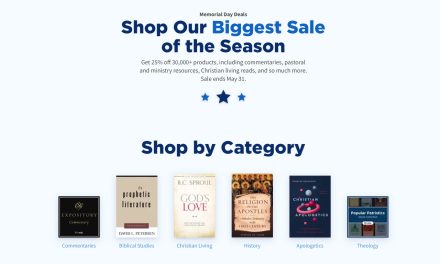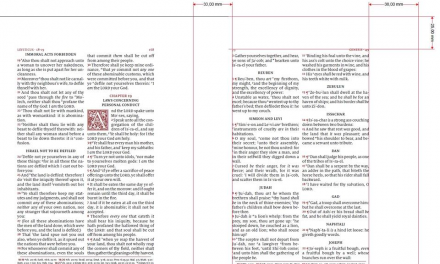I recently had the opportunity to interview with Trevin Wax – a Bible publisher and one of the great minds behind the Holman CSB Reader’s Bible. Trevin discusses the importance of the reader’s Bible trend and provides some insights on the development of the CSB Reader’s Bible. He even gives a quick comparison of digital vs print Bibles.
Here’s the complete unedited interview.
Introduce yourself to our readers.
My name is Trevin Wax. I currently serve as the Bible and Reference Publisher at Broadman and Holman. I’m also a writer and blogger and a teaching pastor.
You worked on the CSB Reader’s Bible. What was your role and how did that project come about?
This was one of the projects I took a particular interest in when I began my role as Bible publisher. I’ve long appreciated the Reader’s Bible trend (whether published by NIV, ESV, or the Kickstarter campaign Bibliotheca). The opportunity to combine of ease in reading as well as beauty of presentation made this a project of high interest for me. I led the Design and production teams in our discussions about font size, layout, thickness and opacity of paper, cover materials, how we would allow “pauses” in the text in reading, the use of two-color, etc. Every time we’d be close to a final design, it seemed like we’d find something to tweak—minor improvements that added up to a richer and more compelling reader experience.
What is a Reader’s Bible and what makes it different from any other Bible? What makes the CSB Reader’s Bible different from other reading Bibles?
The Reader’s Bible is focused on the simplicity of the Bible. No helps. No footnotes. No verses or chapter numbers (usually). So that you dive into the Bible in its simplified form and focus on reading large swaths of Scripture at one time. People who have never read the Bible this way are often amazed at the difference of experience. One person recently told me that he never realized how much he was “counting along” the verses when he read, until those were stripped out of the text and the focus was completely on the words.
The CSB Reader’s Bible follows in the footsteps of beautifully-crafted Reader’s Bibles like Bibliotheca (in its size and approach to the text) and the ESV one-volume Reader’s Bibles. One of the aspects that makes the CSB Reader’s stand out is the readability of the translation itself. It is simply a delight to read this particular translation because of its commitment to both accuracy and readability as a core value. Another aspect that sets the CSB Reader’s Bible apart is the beauty of the page in its presentation. People have remarked on this particular design and layout as being even more reader-friendly than some of the other very good options out there.
How has the CSB Reader’s Bible changed the way you interact with God’s Word? Do you use it more than other types of Bibles?
I use the Reader’s Bible daily. It’s the main Bible I read. I find that it helps me to read large portions of the Bible without wondering how many chapters or verses I’ve covered. I dive into the story and just read, as if I were reading another book. I use different Bibles for church use or when I’m preaching. Verses and chapter numbers are helpful in many circumstances, and study Bibles can be an enormous help in understanding and applying Scripture. But the Reader’s Bible is still my go-to Bible. I read it in the morning and evening every day.
What are some of your favorite Reader’s editions in other translations and what makes them your favorites?
I appreciate the Books of the Bible in the NIV for the way they change up the order of the biblical books so as to bundle certain books together, whether by author or theme or some other connection. I appreciate the ESV one-volume Reader’s Bible for setting a standard of beauty and elegance for this genre of Bible. Bibliotheca, of course, put a major emphasis on beauty and presentation, and I appreciate the opportunity to dip into the literary beauty of the revised ASV translation they used.
Do you see the Reader’s Bible as important for our society? If so, what makes it important? Is it just a matter of reading the Bible as literature or do you think it’s more than that?
Anything that gets more people reading the Bible is good for our society. Reader’s Bibles are not just about encountering the Bible as literature, but about encountering the Bible in bigger chunks at a time, feeling your way through the Bible’s grand narrative. I want to lead a team that produces Bibles people actually read and meditate on, and this genre helps us do that.
Do you think the Reader’s Bible trend is here to stay?
I certainly hope so. I’m not one to chase fads or fashions, and I can’t see my view of Reader’s Bibles changing any time soon. At one point, including verses and chapter numbers was a “trend” and something new, and yet a thousand years later, Bibles that are formatted that way are still going strong. I don’t see Reader’s Bibles replacing ordinary Bibles, but I see them as a complement.
Do you think the design concepts of Reader’s Bibles will affect the design of traditional Bibles?
I hope so. Bibles should be designed in a way that invite people to read, to let your eyes linger on the page. In an age where digital Bibles are so prevalent, you’d think that print Bibles would be less important. It’s actually the opposite. When people choose to sit down with a bound Bible instead of just an app on their phone, they’re more likely to care about the design of the Bible and the experience of reading the printed page, not less.
You’re also an author. What are some of your most popular books and do you have anything new coming out?
My most recent book is This Is Our Time: Everyday Myths in Light of the Gospel. It’s a book that lays out what faithfulness to Christ looks like in an age in which we are often overwhelmed, confused, and uncertain about the rapid changes we see in culture. We touch on various spheres of life, from smartphone usage, to political involvement, to consumerism and shopping, sex and marriage, Hollywood, etc. I’ve also written other books for the church, including Counterfeit Gospels and Gospel-Centered Teaching.
Where can our readers learn more about you, your books, the CSB Reader’s Bible, and other projects you’re working on?
CSBible.com will give you info on a number of CSB-related products. My website trevinwax.com is where I write regularly and give updates on different projects.
Ending Thoughts
I am grateful to Mr. Wax (and B&H/LifeWay) for taking to time to respond and for his insights on Bible design and usage. He’s given us an inside look of the B&H Bible design process, his experience with reader’s editions, and listed several excellent editions including my current favorite complete reader’s edition – the CSB Reader’s Bible.
I’m especially pleased to learn that readers are more likely to care about Bible design in printed editions even though they have so many digital options available. I personally believe that the printed Bible will always be popular and now that we have reader’s editions we can read it without all the distractions. The reader’s Bible trend is one that I hope stays around and becomes even more popular. I’m personally hoping to see a KJV equivalent of the CSB Reader’s Bible.
If you haven’t tried a reader’s Bible I highly recommend them, and I especially recommend the Holman CSB Reader’s Bible for its elegant design. Trevin and his team have set the bar high and it’s a design that we will all benefit from as other publishers take notice. You can see the review here: Holman’s CSB Reader’s Bible – Review.











Recent Comments